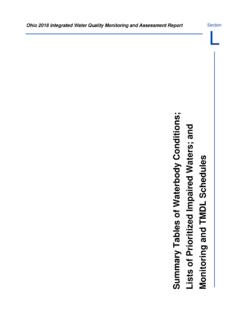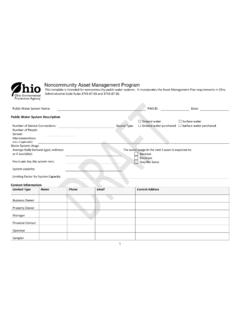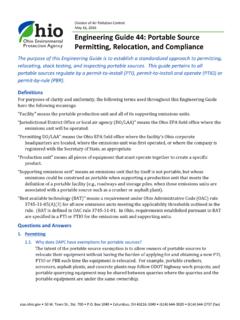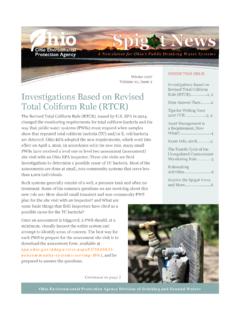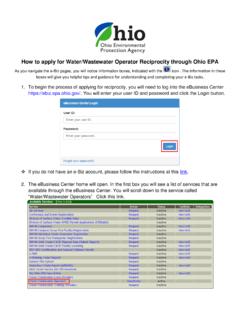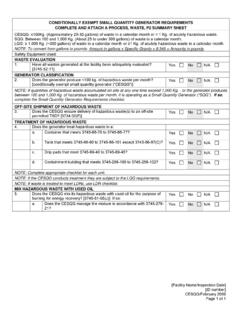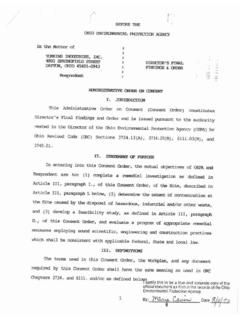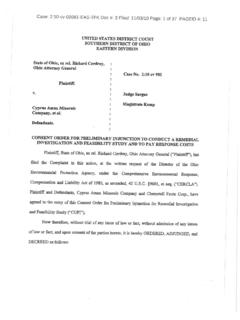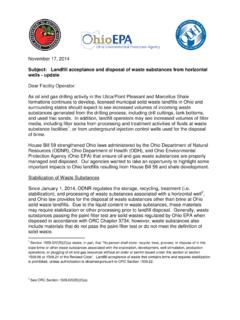Transcription of Nutrient Mass Balance Study for - Ohio EPA
1 Nutrient mass Balance Study for Ohio's Major Rivers Division of Surface Water Modeling, Assessment and TMDL Section December 30, 2016. State of Ohio Nutrient mass Balance Study Table of Contents Executive Summary .. 1. 1 Introduction .. 5. Past Studies and Associated Work .. 7. 2 Methods .. 7. Overall Loading Calculation .. 7. Point Source Loading .. 7. HSTS 8. Nonpoint Source Loading .. 10. 3 Results and Discussion .. 11. Statewide Analysis .. 11. Watershed Area .. 11. Relationship of Annual Water Yield to Annual Load .. 11. Nonpoint Source Nutrient Yield .. 15. Per Capita Nutrient Yield.
2 15. Population Density .. 16. Relative Loadings .. 16. Maumee River .. 18. Portage River .. 22. Sandusky 25. Cuyahoga River .. 29. Great Miami River .. 32. Scioto River .. 35. Muskingum River .. 38. 4 Summary and Future Work .. 41. Acknowledgements .. 43. References Cited .. 44. Appendix A Spring Nutrient Loading for Selected Lake Erie Tributaries .46. Appendix B Summary Tables for mass Balance Calculations .50. State of Ohio Nutrient mass Balance Study Executive Summary Since 2011, more than $ billion has been allocated statewide to address both point source and nonpoint source Nutrient reduction, drinking water treatment, home sewage treatment systems, and drinking and wastewater infrastructure improvements.
3 Of that total, $ billion has been spent in the Lake Erie basin. The following is a list of statewide water quality improvement activities underway to address nutrients and harmful algal blooms. 1. Statewide Nutrient Reduction Strategy: Ohio's environmental, agricultural and natural resource agencies worked together to create a statewide strategy to reduce Nutrient loading to streams and lakes, including Lake Erie. The strategy was submitted to EPA Region 5 in 2013. Ohio EPA recently updated the strategy to address gaps identified through EPA's review. The strategy and more information about the effort are available at 2.
4 Water Quality Bill: Senate Bill 1 became effective July 3, 2015, requires major publicly owned treatment works (POTWs) to conduct technical and financial capability studies to achieve mg/L total phosphorus; establishes regulations for fertilizer or manure application for persons in the western basin 1; designates the director of Ohio EPA as coordinator of harmful algae management and response and requires the director to implement actions that protect against cyanobacteria in the western basin and public water supplies; prohibits the director of Ohio EPA from issuing permits for sludge management that allow placement of sewage sludge on frozen ground; and prohibits the deposit of dredged material in Lake Erie on or after July 1, 2020, with some exceptions.
5 3. Agriculture Water Quality Bill: SB 150, effective August 21, 2014, requires that beginning September 31, 2017, fertilizer applicators must be certified and educated on the handling and application of fertilizer and authorizes a person who owns or operates agricultural land to develop a voluntary Nutrient management plan or request that one be developed for him or her. 4. State Budget Bill: HB 64, effective June 30, 2015, requires the development of a biennial report on mass loading of nutrients delivered to Lake Erie and the Ohio River from Ohio's point and nonpoint sources.
6 A summary of the bill is available at This report fulfills this requirement for 2016. 5. Great Lakes Restoration Initiative Demonstration and Nutrient Reduction Projects: Nine grants totaling over $12. million were awarded to Ohio. Highlights include: first saturated buffer installed in Ohio; 53 controlled drainage structures installed; 52 whole farm conservation plans developed; 7,500 acres of cover crops planted; and 29. storm water, wetland and stream restoration projects in Cuyahoga County. 6. Ohio Clean Lakes Initiative: In 2012 the Departments of Natural Resources, Agriculture and Ohio EPA created the Ohio Clean Lakes Initiative.
7 The Ohio General Assembly provided more than $ million for projects to reduce Nutrient runoff in the Western Lake Erie Basin beginning in 2013. Western basin is defined in this Senate Bill as consisting of the following 11 watersheds: Ottawa watershed, HUC 04100001; River Raisin watershed, HUC 04100002; St. Joseph watershed, HUC 04100003; St. Mary's watershed, HUC. 04100004; Upper Maumee watershed, HUC 04100005; Tiffin watershed, HUC 04100006; Auglaize watershed, HUC. 04100007; Blanchard watershed, HUC 04100008; Lower Maumee watershed, HUC 04100009; Cedar-Portage watershed, HUC 04100010; and Sandusky watershed, HUC 04100011.
8 1. State of Ohio Nutrient mass Balance Study 7. Healthy Lake Erie Fund: In 2014 the Ohio General Assembly, provided $10 million to the Healthy Lake Erie Fund to reduce the open lake placement of dredge material into Lake Erie. These sediments often contain high levels of nutrients or other contaminants so finding alternative use or disposal options is a priority. 8. Western Basin of Lake Erie Collaborative Plan: This agreement between Ohio, Michigan and Ontario will serve as a precursor to the Great Lakes Water Quality Agreement Domestic Action Plan. The Collaborative establishes an implementation plan with the goal to achieve a 40% reduction for total and dissolved reactive phosphorus from entering Lake Erie by 2025.
9 9. Targeted Funding to Ohio Drinking Water and WWTPs: More than $150 million was made available starting in 2014 to help public water systems keep drinking water safe and to help wastewater treatment plants reduce the amount of phosphorus they discharge into the Lake Erie watershed. As of June 2016, more than $61 million had been awarded for this work and most of the remainder has been allocated for specific projects. 10. Directors' Agricultural Nutrients and Water Quality Working Group: A collaborative working group consisting of experts from Ohio EPA, ODA and ODNR developed the group's 2012 report, which contains a number of recommendations to be implemented during the next several years.
10 For example, the report recommends ways for farmers to better manage fertilizers and animal manure and also provides the state with the means to assist farmers in the development of Nutrient management plans and to exert more regulatory authority over the farmers who are not following the rules. The report is available at 11. Ohio Lake Erie Phosphorus Task Force 2: The Task Force, which includes participants from Ohio EPA, ODA and ODNR, came together in 2012 to build on its previous work and make recommendations for improving water quality in the Lake Erie watershed. The task force finalized a report in 2014 recommending a 40% reduction for total and dissolved reactive phosphorus.
